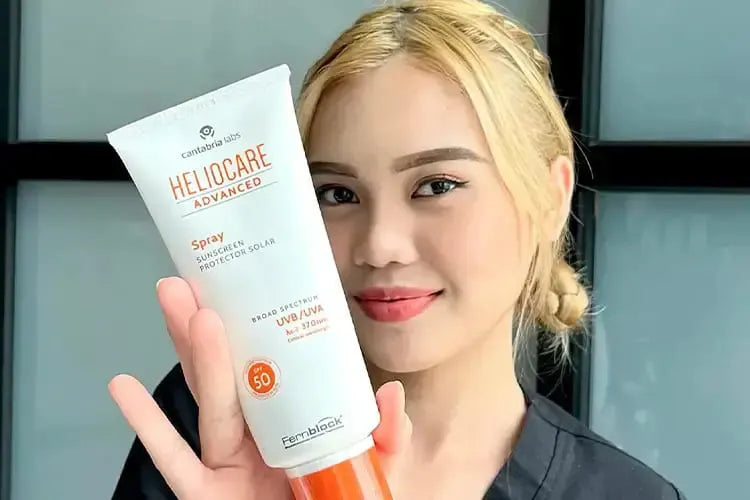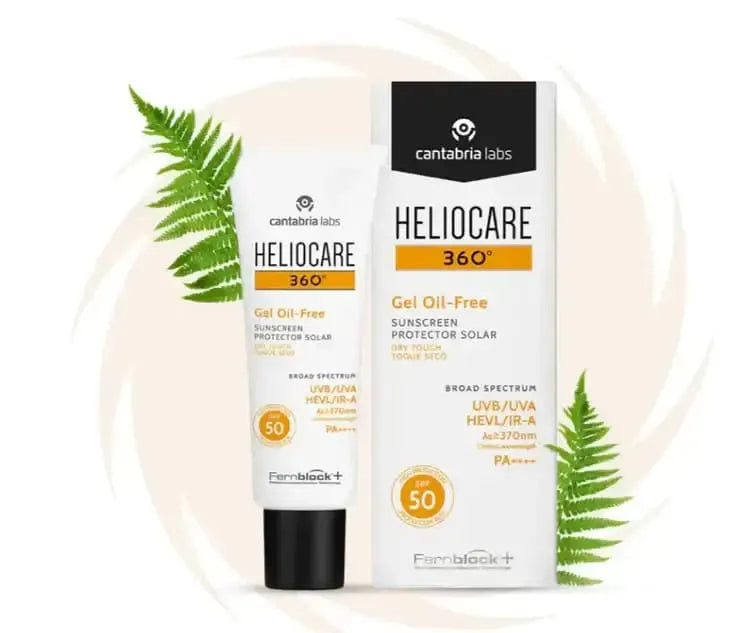Are acne flare-ups photobombing your summer selfies? You're not alone, Love. Scientific evidence confirms this seasonal pattern: According to the Journal of Cosmetic Dermatology, a study of 171 patients found that 40.4% suffered worse acne during summer months, with statistics showing significantly higher aggravation compared to winter and rainy seasons.
Sun exposure creates a perfect condition for excess oil production and breakouts, while the challenge of finding a sunscreen that won't clog your pores only adds to the frustration. Even then, skipping sun protection is never an option, as UV rays damage your skin and can actually intensify breakouts. Your best defence? A high-performance SPF50 sunscreen with noncomedogenic ingredients specifically crafted for acne-prone skin.

The Science Behind Acne
Acne is a widespread skin condition that erupts as painful red bumps across the face and sometimes on the body. These frustrating breakouts happen when skin pores become clogged with oil and dead skin cells. While acne commonly appears during teenage years due to the hormonal rollercoaster of puberty, many adults also battle breakouts due to acne-prone skin, family history of acne, hormonal fluctuations, and other underlying factors that keep the red bumps coming long after high school.
UV exposure is known to exacerbate acne by increasing sebum production and inflammation. According to research published in the European Journal of Dermatology, sebum levels nearly doubled in the studied acne patients during the first three days following UVA & UVB irradiation. This research highlights how sun protection plays a crucial role in regulating sebum production and subsequently acne.
The Acne Cycle - How It Happens
Let’s talk about the 4 stages that cause red bumps, blackheads, or whiteheads to erupt on your skin.
Stage 1: Clogged skin pores
Your skin naturally renews itself every month, shedding old cells to make way for new ones. But for acne-prone skin, the remnants of these dead cells don't shed effectively as the excess oil/sebum traps them alongside acne-causing bacteria and seals them within your pores, setting the stage for breakouts.
Stage 2: Excess sebum (oil) production
One of the telltale signs that your skin is about to experience an acne nightmare is the overproduction of sebum triggered by summer. Under the scorching heat, the skin undergoes significant moisture loss. To compensate for this lack of moisture, your skin responds by ramping up the oil production to prevent dehydration. This defense mechanism quickly backfires, clogging pores and sparking breakouts. Research reveals that sun exposure significantly boosts sebum secretion, especially in acne-prone skin. A study published in the Egyptian Journal of Dermatology and Venerology found that individuals with increased sun exposure had more than twice the likelihood of developing acne than those with less sun exposure.
Stage 3: Onset of breakouts
Now the real trouble begins. At this critical stage, the acne-causing bacteria called Propionibacterium acnes, entrapped within your pores, thrive on the abundance of oil and dead skin cells. Supported by an ideal breeding ground with loads of nutrition, these bacteria multiply rapidly and flourish, subsequently leading to acne flare-ups you see and feel on your skin's surface.
Stage 4: Aggravation of Acne
The situation gets worse as the acne-causing bacteria continue their feast, releasing byproducts your immune system identifies as foreign. In response, your body launches its immune defence, dispatching white blood cells to the affected area. What happens next? Inflammation in the form of pus, swelling, redness, and ultimately, the development of painful, throbbing acne lesions.

Role of Summer in Worsening Acne
Sebum secretion reaches its peak during summer. UV exposure is one of the major culprits, triggering the skin to overproduce oil and cause inflammation. Even worse, UVA rays promote the formation of comedogenic squalene monohydroperoxide on the skin's surface, clogging pores and leading to stubborn acne. According to the Journal of Dermatology, UVB not just stimulates sebum production but also significantly increases inflammation, potentially exacerbating the existing acne lesions.
This is why a good SPF50 sunscreen is absolutely non-negotiable for acne-prone skin to protect it from UV damage. However, there's a catch: many sunscreens contain comedogenic ingredients that paradoxically worsen acne, leaving many wondering how to protect their skin without triggering more breakouts.
Steer Clear of These Pore Cloggers to Avoid Acne
Let's look at some of the comedogenic ingredients to avoid. Make sure to check your SPF50 sunscreen's label for these little red flags:
-
Moisturising Oils & Butters: Coconut oil, cocoa butter, and lanolin might have earned reputations as hydration heroes, but their thickness poses a major problem. Too dense to properly penetrate skin, these heavy oils & butters linger on the surface, creating a sticky layer that traps debris, sweat, and bacteria beneath - a perfect recipe for clogged pores.
-
Benzophenones: Popular UV filters, such as Oxybenzone and Avobenzone, protect your skin from sun damage, but they're notoriously problematic for acne-prone skin. These UV filters can trigger breakouts in individuals with acne-susceptible skin, undoing all the careful skincare efforts.
-
Alcohols & Parabens: Generally found in fast-absorbing sunscreens, these ingredients help the application dry quickly. But at what cost, Love? While alcohols & parabens rapidly eliminate the greasy feeling, they also strip your skin of its natural moisture, triggering irritation and inducing excess oil production.
-
Strong Fragrances: Strong fragrances with harsh alcohols rob your skin of its natural moisture. In contrast, SPF50 sunscreen containing naturally derived ingredients like linalool and limonene offers a subtle, pleasant scent that won't compromise hydration.
-
Algae Extract: Algae, being a rich source of omega-3 fatty acids, are known to be deeply hydrating. However, they also contain concentrated iodides that can irritate and inflame acne-prone and even non-sensitive skin types. Worse, Algae particles can infiltrate pores and form micro-comedones, laying the groundwork for future breakouts.
-
Kelp: Similar to Algae, Kelp also has high levels of Iodine, making it more likely to trigger unexpected acne flare-ups, skin irritation, and stubborn pore blockages that prove difficult to purge.

What to look for in an ideal SPF50 sunscreen
Not wearing sunscreen for the fear of clogged pores and breakouts is like burning down your house to get rid of the rats. By skipping sun protection, you are inviting a host of bigger problems in addition to acne, including wrinkles, dark spots, and even the risk of skin cancer.
Don't compromise your skin's health. Instead, explore sunscreens specifically crafted for skin that’s prone to breakouts. If acne is the concern, your perfect SPF50 sunscreen should be:
-
Noncomedogenic: At the top of any pore-clogging culprits list sit comedogenic ingredients. Hunt for an SPF50 sunscreen proudly labeled noncomedogenic, but don't stop there, Love! Double-check the ingredients list to confirm the sunscreen truly lives up to its claim and won't sabotage your clear-skin efforts.
-
Oil-Free: Acne-prone skin has a frustrating tendency to overreact to dryness by pumping out excess oil. Choosing an oil-free, hydrating SPF50 sunscreen gives your skin that perfect "dry touch" finish without any greasy sensation.
-
Ultra-Light: Your sunscreen should protect without announcing its presence. Prioritise sunscreens specifically formulated to be lightweight and virtually imperceptible after application. The ideal formula works diligently in the background without crushing your skin under its weight.
-
Sebum-Regulating: Combat your skin's tendency to overproduce oil by selecting an SPF50 sunscreen infused with powerful sebum regulators. These regulators provide advanced oil control throughout the day, preventing the midday shine that often plagues acne-prone skin.
-
Mattifying: To avoid oily, unwanted shine on your face, go for an SPF50 sunscreen with a matte finish. Mattifying sunscreens give you an enviable velvety-smooth finish that looks perfect in any lighting - the secret behind many celebrities' polished, camera-ready skin.
-
Antioxidant-Rich: Upgrade your sun protection with a multitasking SPF50 sunscreen enriched with powerful antioxidants like Vitamin C, Vitamin E, and Green Tea. This winning combination not only shields against harmful UV rays but also eliminates free radicals that silently damage skin cells and accelerate aging.
- Paraben- & Alcohol-Free: As highlighted earlier, alcohols and parabens found in some sunscreens can severely dehydrate your skin. Always check the label to ensure that your chosen SPF50 sunscreen is paraben-free and alcohol-free.
Dermats’ Top Recommended SPF50 sunscreen for acne-prone skin
Does battling acne during summer seem like a never-ending struggle? Never say never, Love. Heliocare 360º Gel Oil-Free is here as your skin's powerful ally against persistent breakouts.
This high-performance SPF50 sunscreen not just delivers sun protection, it does more. The formula contains potent anti-bacterial and anti-acne ingredients to fight off bacterial infections behind those frustrating blemishes and acne lesions. Its anti-inflammatory properties also work diligently to soothe redness and calm irritated skin.
Powered by the revolutionary Spanish Fernblock®+ Technology and skin-DNA-repair enzymes, Gel Oil-free SPF50 Sunscreen provides broad-spectrum protection against harmful sunrays and blue light while actively repairing past UV damage and boosting your skin's natural immunity. The SPF50 Sunscreen's unique oil-control technology puts a lid on excess sebum production, leaving your skin with a velvety matte finish.
SPF50 Sunscreen Application Tips for Acne-Prone Skin
The right results are always seen with the right application. Follow these best practices to get the most from your SPF50 sunscreen:
- Cleanse: Start with a clean slate. Before applying SPF50 sunscreen, use a gentle oil-free cleanser like micellar water to remove dirt, grime, and oil from your face, creating the ideal canvas for protection.
-
Apply Sunscreen: Take two finger-lengths of your SPF50 sunscreen and gently apply it over your face. Blend it subtly without excessive rubbing that could irritate the skin.
Wear sunscreen 15-20 minutes before stepping out to allow proper absorption and formation of a protective barrier.
- Wear Makeup (optional): Wait for your sunscreen to fully absorb and form a film before reaching for makeup brushes. A few minutes of patience ensure your protection stays powerful beneath your dolled-up look.
- Blot Out Excess Oil: Throughout the day, use skin-grade tissue papers to lightly dab away any excess oil, especially before reapplying sunscreen for maximum effectiveness.
- Reapply Every 2 Hours: Remember, even the best sunscreen needs reapplication every 2 hours, especially during outdoor adventures. If you're a hustler, a sunscreen stick like Heliocare 360º Sport Transparent Stick makes reapplication incredibly simple – just swipe and go.
To Summarise
Dreaming of clear, acne-free skin and actually working towards it are two different things. Every step you take, every change you make, brings you closer to freedom from those frustrating breakouts.
An absolute essential in your skin-clearing toolkit is the daily application of Heliocare 360º Gel Oil-Free SPF50 sunscreen, which defends against UV rays known to trigger breakouts and worsen existing acne.
Why wait another day, Love? Now is a good time as any to embark on your skin-clearing mission with Heliocare 360º Gel Oil-Free SPF50 sunscreen as your trusted ally.






